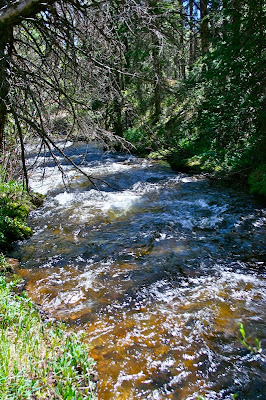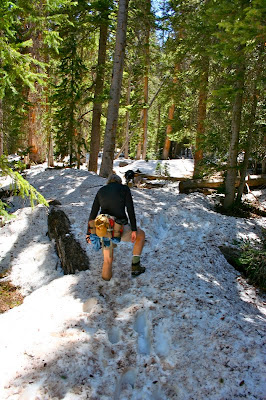Distance: 6.67 miles round trip to to the Homestead Act sign, 6.88 miles roundtrip to the first homestead sign, 7.12 miles roundtrip to the Walker Homestead, 8 miles round trip to the Griffith homestead
Elevation: 7,370 ft - 8,447 ft
Elevation Gain: 1,077 ft (net), 1,387 ft (cumulative)
Dogs: Off Leash (this is Forest Service land)
 The Griffith Homestead (2003)
The Griffith Homestead (2003)
The Lion Gulch Trail (off of Hwy 36 going to Estes Park) is one of the few Forest Service trails within easy driving distance of Boulder. It is not my favorite trail because the views are few and the water crossings many but on the right day it can be serene and welcoming.
 The trailhead
The trailhead
 One of the nicer trail segments
One of the nicer trail segments
This trip, was not the right day! Due to recent snowfall, the Little Thompson River was overflowing its banks and we had to navigate around 6 tricky water crossings. Two of those were across dead fall that previous hikers had lain in a pile in the torrent. That sort of crossing fills me with anxiety. I have no desire to get my camera wet or twist and ankle and be out for the season. We managed to get across though with the help of another large branch that we used like a giant's walking stick.
 The creek in a kinder, gentler time of year
The creek in a kinder, gentler time of year
Much of Lion Gulch is in the trees
We ended up on this trail because it was lower in elevation than others and our recent May snow storm had left a pile of the white stuff in all the places we wished to go. Alas, one mile into the journey we ran into snow and it stayed with us the whole way. I would have really thought that the snow in the wide-open expanses of Homestead Meadows would have melted in the direct sun, but it had not. It felt like January, not May. Not the best time to visit Lion Gulch. At least we got some exercise.
 The entrance to the meadow (2003)
The entrance to the meadow (2003)
 Looking to the side of the trail (2003)
Looking to the side of the trail (2003)
This trail can be quite appealing in the summer, however, when the grasses are green and the sky is blue. Since this trip was rather dreary, I have decided to use photos from an earlier trip done in the summer of 2003 (my last trip to the area) to illustrate the route and so hopefully not turn you off with all my negative comments.
 The first homestead is at the top of the rise (2003). In 2010 the trail was filled with flowing run off.
The first homestead is at the top of the rise (2003). In 2010 the trail was filled with flowing run off.

The first homestead is in the trees to the right and the Griffen Homestead is through the trees at the back of the photo (2003).
The trail itself leads to Homestead Meadows, a wide open area filled with old cabins from the 1930s. My favorite cabin, the Griffen Cabin, has fallen down in the 5 years since I have hiked this trail. That was sad to see indeed. It was quite picturesque sitting next to a large Ponderosa Pine.
 Getting closer to the Griffen Homestead (2003)
Getting closer to the Griffen Homestead (2003)

The remains of the first homestead
The other things to note about this trail are:
- There is a very large parking lot and bathroom at the trailhead.
- The trail descends sharply down to the river and then winds back upwards until it rises above the road.
- There are quite a few water crossings.
- The trail is rocky in places and there is one very steep and rocky ascent.
- The mileage listed in most trail guides is just to the entrance of the meadow. Visiting the homesteads is an additional distance.

If you like hiking in the trees along a vocal river, then Lion Gulch may just be the trail for you. Homestead meadows is a pleasant area and I can see why the homesteaders themselves chose to live there despite the hardships.
 The backside of the Griffen cabin (see the teaser photo for the front) in 2010. Most of it has collapsed.
The backside of the Griffen cabin (see the teaser photo for the front) in 2010. Most of it has collapsed.

May 2010 was not the best time to visit Lion Gulch
Once you get into the meadow, you can hike for miles if you like. I recently had two friends do this. They promptly got lost and wandered around for 9 hours. There is a lesson for you, always carry a map!























































